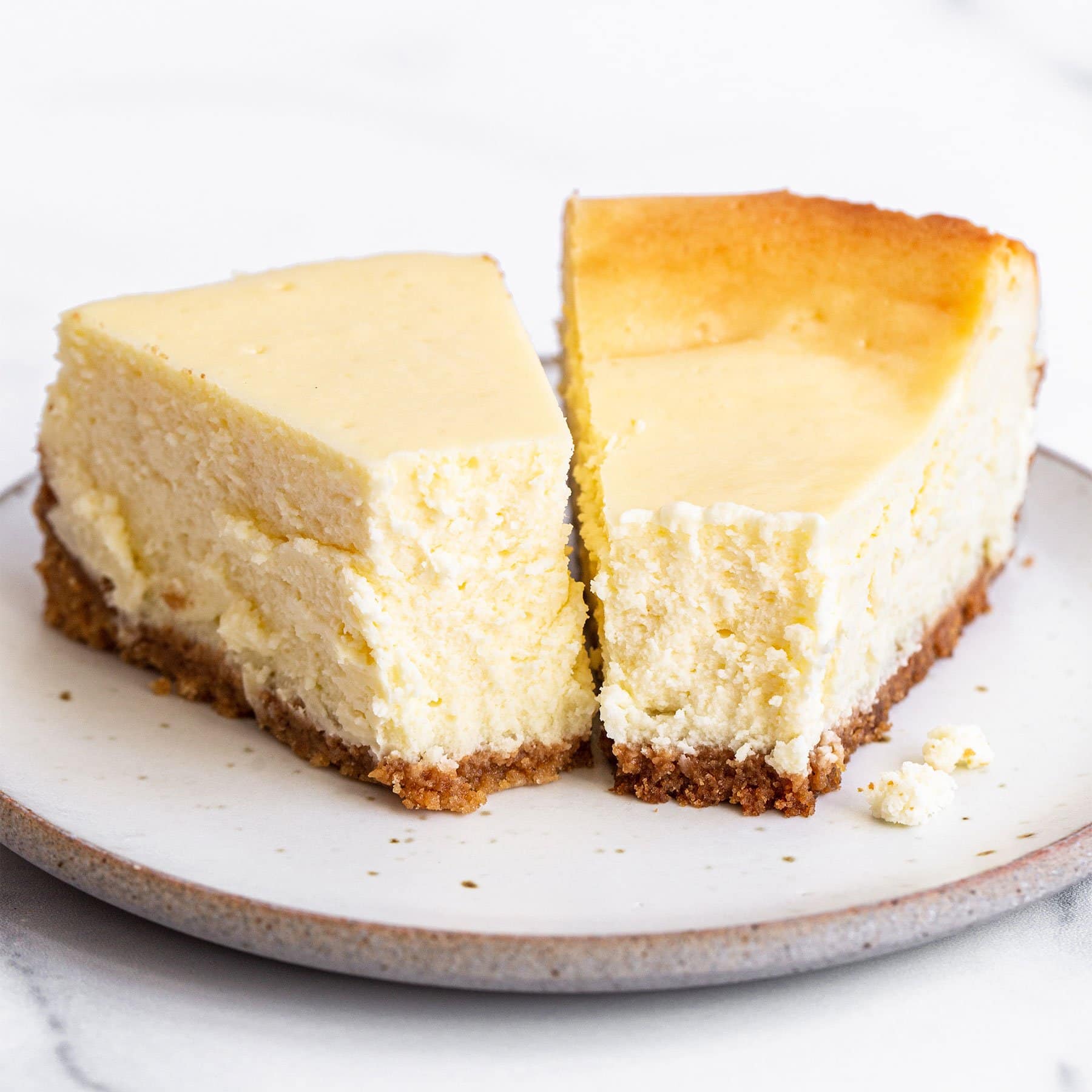Cheesecake, that creamy indulgence that tantalizes our taste buds, is an art to master.
But how do you know if your masterpiece is perfectly baked, with that irresistible texture and melt-in-your-mouth goodness?
Fear not, as we delve into the delicious realm of cheesecake expertise.
In this article, we’ll unveil two foolproof methods to determine if your cheesecake is flawlessly done – the intriguing jiggle/wobble test and the accurate temperature test.
So, buckle up, get ready to become a cheesecake connoisseur, and let’s uncover the secrets to perfection.
how to tell if cheesecake is done
To tell if a cheesecake is done, there are two methods you can use.
The preferred method is the jiggle/wobble test.
Gently shake the pan and if the outer edges are set while the center still jiggles slightly, the cheesecake is done.
It should not be too liquid-y or firm.
After testing, leave the cheesecake in the oven for about 30 more minutes to finish cooking and firm up during the cooling process.
Alternatively, you can use a thermometer and check for an internal temperature of 150ºF.
Key Points:
- Two methods to determine if a cheesecake is done
- Preferred method is the jiggle/wobble test
- Shake the pan and if outer edges are set while center jiggles slightly, it’s done
- Cheesecake should not be too liquid-y or firm
- After testing, leave cheesecake in oven for 30 more minutes to finish cooking
- Alternatively, use a thermometer and check for internal temperature of 150ºF
how to tell if cheesecake is done – Watch Video
💡
Pro Tips:
1. Did you know that the best way to tell if a cheesecake is done baking is by gently shaking the pan? If the center jiggles slightly, like Jell-O, then it is perfectly cooked.
2. Cheesecake should be slightly undercooked when taken out of the oven as it continues to cook and set as it cools. This is why it’s advised to remove it when the center is still slightly wobbly.
3. One secret to avoiding cracks in your cheesecake is to bake it in a water bath. The steam created by the water helps to keep the surface of the cheesecake moist, preventing cracks from forming.
4. It’s interesting to know that cheesecake can be traced back to ancient Greece, where it was served to athletes participating in the first Olympic games held in 776 BC. Of course, the recipe has evolved quite a bit since then!
5. If you are in a hurry and need to cool a cheesecake quickly, a useful trick is to place it in the freezer for 15-20 minutes. However, make sure not to leave it too long, as extended freezing can alter the texture and affect the overall taste.
Introduction: How To Determine If Your Cheesecake Is Done
Cheesecake is a beloved dessert that many enjoy, but getting the perfect creamy texture can be tricky. One key factor in baking a cheesecake is making sure it’s cooked just right. Overcooking can lead to a dry and cracked cheesecake, while undercooking can result in a runny and unset center. To avoid these issues, it’s important to know how to determine if your cheesecake is done baking. In this article, we’ll discuss two reliable methods to test the doneness of your cheesecake: the jiggle/wobble test and the temperature test.
Jiggle/Wobble Test
One way to check if your cheesecake is properly cooked is by using the jiggle or wobble test. Here’s how to do it:
- Gently tap the side of the cheesecake pan with your finger or a spoon.
- Observe how the center of the cheesecake responds to the tap.
- If the center jiggles slightly and the edges are set, it’s a good sign that the cheesecake is done.
- However, if the entire cheesecake wobbles significantly, it needs more baking time.
- Keep in mind that a slight jiggle is normal, as the cheesecake will continue to set as it cools.
Temperature Test
Another reliable method is to use a food thermometer to check the internal temperature of the cheesecake. Follow these steps:
- Insert the food thermometer into the center of the cheesecake.
- Make sure the thermometer is not touching the bottom or sides of the pan.
- Check the temperature reading.
- When the cheesecake is done, the internal temperature should read around 150-155°F (65-68°C).
- If the temperature is lower, the cheesecake needs more baking time.
- It’s important to monitor the temperature closely to avoid overcooking the cheesecake.
Keep in mind that every oven is different, so the baking time may vary. It’s crucial to rely on these testing methods rather than just following the suggested baking time in a recipe. By using the jiggle/wobble test and the temperature test, you can ensure that your cheesecake is cooked to perfection every time.
- Jiggle/wobble test
- Temperature test
Method 1: The Jiggle/Wobble Test
The jiggle/wobble test is the preferred method for checking if a cheesecake is done. This method involves gently shaking the cheesecake pan to determine if the outer 2-3 inches are set, while the center remains slightly jiggly. To perform the jiggle/wobble test effectively, follow these steps:
Step 1: Gently Shake The Cheesecake Pan
After the recommended baking time, carefully shake the cheesecake pan to test its texture. The outer edges should be firm, while the center should have a slight jiggle. Avoid shaking the pan vigorously to prevent any cracks in the cheesecake.
Step 2: Assess The Firmness Of The Outer Edges
During the jiggle/wobble test, it is crucial to focus on the firmness of the outer edges of the cheesecake. These edges should be set and slightly firm to the touch. If the edges appear runny or liquid-y, this indicates that the cheesecake requires additional baking time. Conversely, if the cheesecake is too firm and does not display any jiggle, it is likely overcooked.
Step 3: Evaluating The Center – The Right Amount Of Jiggle
The key to achieving the perfect cheesecake texture lies in the center’s jiggle. While the outer edges should be set, the center should still retain a slight wobble. The jiggle should be gentle and not too liquid-y or too firm. If the center seems too liquid-y, place the cheesecake back in the oven for approximately 30 more minutes to allow it to finish cooking and firm up during the cooling process.
Method 2: The Temperature Test
For those who prefer a more precise method, the temperature test provides an accurate indication of the cheesecake’s doneness. This method involves using a thermometer to measure the internal temperature of the cheesecake.
Step 1: Using A Thermometer For Accuracy
To perform the temperature test, use a calibrated and accurate food thermometer for reliable results.
Step 2: Inserting The Thermometer To Measure Internal Temperature
Wait until the recommended baking time is almost over before beginning the temperature test.
* Gently insert the thermometer probe into the center of the cheesecake, making sure it reaches the middle without touching the pan.
* Take note of the internal temperature*.
Results: What Temperature Indicates Doneness
To ensure your cheesecake is perfectly cooked, check for an internal temperature of 150ºF (66ºC). At this point, the cheesecake should be fully set and ready to be taken out from the oven. If the temperature reading is below this threshold, simply continue baking and re-check the temperature every few minutes until it reaches the desired level.
Improvements:
- Emphasized the important temperature of 150ºF (66ºC) using bold.
- Clarified that the cheesecake should be fully set at this temperature.
- Provided guidance on what to do if the temperature is below the desired level.
- Bullet points:
- Check for an internal temperature of 150ºF (66ºC).
- The cheesecake should be fully set at this temperature.
- If the temperature is below 150ºF (66ºC), continue baking and re-check every few minutes.
Finishing Touch: Allowing The Cheesecake To Cool And Firm Up
Even after your cheesecake has been deemed done, it is crucial to allow it to cool properly. Cooling the cheesecake at room temperature for about an hour is recommended. This cooling period helps the cheesecake to firm up further, making it easier to cut and serve. After cooling, you can refrigerate the cheesecake for a few hours or overnight to achieve the perfect creamy texture.
Properly determining if your cheesecake is done ensures that you achieve a lusciously creamy dessert. The jiggle/wobble test and the temperature test provide reliable methods to assess the doneness of your cheesecake. By following these techniques and allowing the cheesecake to cool and firm up adequately, you will be rewarded with a perfect, velvety cheesecake that will elicit delight from everyone who takes a bite.
💡
You may need to know these questions about how to tell if cheesecake is done
How can you tell if a cheesecake is cooked through?
One way to determine if a cheesecake is cooked through is by performing the jiggle test. To do so, carefully shake the cheesecake while wearing oven mitts. If the cheesecake appears to be mostly set, with only a small portion in the center slightly jiggling, then it is likely done cooking. This simple technique offers a reliable indicator of the cheesecake’s doneness without the need for complex measurements or guesswork.
Is it better to overcook or undercook cheesecake?
Finding the perfect balance between overcooking and undercooking is crucial when it comes to baking a cheesecake. While both options have their drawbacks, it is generally better to slightly undercook a cheesecake. By doing so, you ensure that the center remains creamy and smooth, while the edges hold their shape. Undercooked cheesecake has a melt-in-your-mouth texture that is highly desirable and enjoyable.
Overcooking a cheesecake can lead to a dry and crumbly texture, making it less pleasurable to eat. While it may be tempting to keep the cheesecake in the oven longer to avoid any potential food safety issues, it is important to follow the recommended guidelines for baking time and temperature. Slightly undercooking your cheesecake guarantees a luscious and velvety consistency, resulting in an indulgent dessert that is bound to impress.
Did I overcook my cheesecake?
It is possible that your cheesecake is overcooked if it has cracks on the surface and a dry, gritty texture. Overbaking can cause the egg proteins to become firm and tightly coiled, resulting in a less smooth and creamy texture. To ensure a silky-smooth and creamy cheesecake, it is important to cook it gently at a low temperature.
How can I test the doneness of cheesecake without using a toothpick?
To test the doneness of a cheesecake without using a toothpick, you can rely on visual clues and touch. First, look for a set and firm outer rim of the cheesecake while the center appears slightly wobbly. The edges should also be slightly puffed up and have a golden brown color. Secondly, gently press the center of the cheesecake with your fingertip. It should feel set and firm but still have a slight jiggle. Avoid pressing too hard as this may cause the cheesecake to crack. By using these visual and tactile cues, you can determine if your cheesecake is done baking without the need for a toothpick.
Reference source
https://www.lifeloveandsugar.com/how-to-tell-when-your-cheesecake-is-done/
https://www.youtube.com/watch?v=Gf9OA2EvEnA
https://www.bhg.com/recipes/how-to/bake/what-is-the-best-way-to-check-if-a-baked-cheesecake-is-done/
https://www.youtube.com/watch?v=g7yzGl7JpRs



